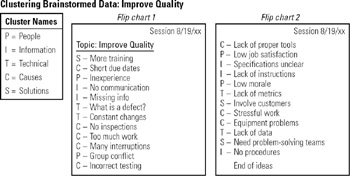Tool 35: Cluster Analysis
| AKA | Clustering |
| Classification | Evaluating/Selecting (ES) |
Tool description
The cluster analysis tool is best utilized after a brainstorming session to organize data by subdividing different ideas, items, or characteristics into relatively similar groups, each under a topical heading. Mainly a discovery tool, it often surfaces perceived problem areas, concerns, or items that naturally belong together.
Typical application
-
To classify data into natural grouping on the basis of similar or related characteristics.
-
To identify most important characteristics to be considered in developing a problem specification.
-
To develop a more homogeneous group of items from a large list of dissimilar items.
-
To identify differences among customer, employee, or supplier groups in regard to quality perception and performance issues.
Problem-solving phase
| → | Select and define problem or opportunity |
| → | Identify and analyze causes or potential change |
| Develop and plan possible solutions or change | |
| Implement and evaluate solution or change | |
| Measure and report solution or change results | |
| Recognize and reward team efforts |
Typically used by
| Research/statistics | |
| 1 | Creativity/innovation |
| Engineering | |
| 3 | Project management |
| Manufacturing | |
| 5 | Marketing/sales |
| Administration/documentation | |
| Servicing/support | |
| 4 | Customer/quality metrics |
| 2 | Change management |
before
-
Brainstorming
-
Brainwriting Pool
-
6-3-5 Method
-
Double Reversal
-
Starbursting
after
-
Problem Specification
-
Pareto Chart
-
Opportunity Analysis
-
Force Field Analysis (FFA)
-
Nominal Group Technique (NGT)
Notes and key points
-
Cluster analysis is simply a classification process that combines similar objects, items, ideas, variables, or issues into categories or groups.
Step-by-step procedure
-
STEP 1 The team facilitator displays the flip charts of previously brainstormed data to the team. See example Clustering Brainstormed Data: Improve Quality.
-
STEP 2 The team look at all items and suggests general or topical headings for similar items. They become the cluster names.
-
STEP 3 The facilitator records all suggested cluster names and asks participants to sort or organize items to be placed under each cluster name. As participants call out items, the facilitator designates the items on the flip charts with the first letter of the cluster name as shown in the example.
-
STEP 4 Once all items have been designated, a final chart of formed clusters (groups) is drawn.
-
STEP 5 The resulting cluster chart is dated and saved for future reference.
Example of tool application
Clustering Brainstormed Data: Improve Quality

| Resulting Clusters | Date: xx/xx/xx | |||
|---|---|---|---|---|
| People | Information | Technical | Causes | Solutions |
|
|
|
|
|
EAN: 2147483647
Pages: 326